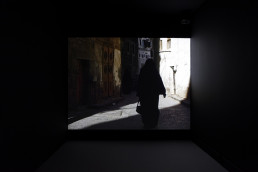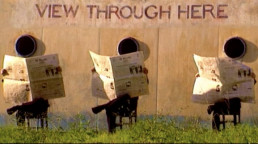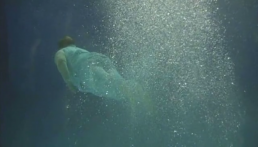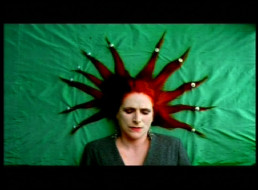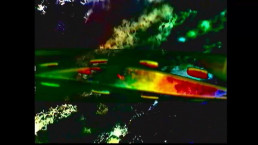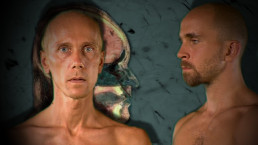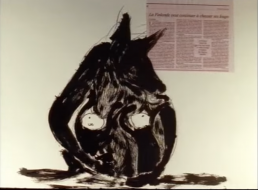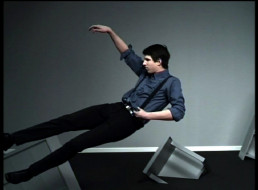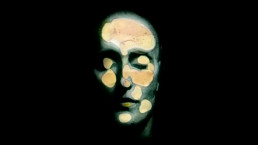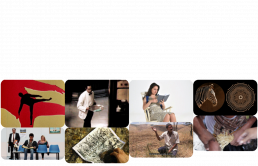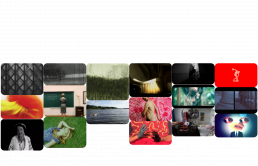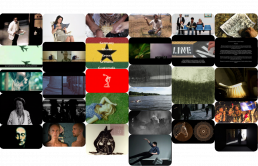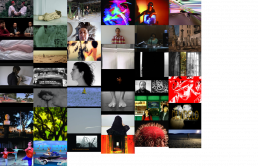“FUSO 2014 – 27 a 31 de Agosto“
Programação
29 Agosto, 22h
Museu Nacional de Arte Contemporânea (MNAC) – Museu do Chiado
“UNFRAMED”: THE INVIDEO COMPILATION FOR FUSO
Curadoria de Sandra Lischi
Duração da sessão 68’
Dança, animação, música visual, imagens abstratas, e, ao mesmo tempo, nenhuma definição para este tipo de obras. Unframed (Sem moldura). Brincadeira, sonho, surpresa, incomunicabilidade, coreografias extravagantes, enigma, encontros, uma visão curiosa sobre o mundo. Poesia. Um panorama de imagens diferentes, capazes de inventar formas não-padronizadas de descrever, revelando, aludindo, detonando reflexão. Interferências entre imagem e música, desenho e poesia, dança. Uma pequena seleção retratando alguns tipos de obras de não-ficção apresentadas recentemente pelo INVIDEO.
INVIDEO – International Exhibition of Video Art and Cinema Beyond -, organizado desde 1990 pelo A.I.A.C.E. em Milão, representa um ponto de referência para o vídeo não ficcional na Itália e estabeleceu-se como uma referência internacional para uma ampla série de produções audiovisuais ligadas à arte eletrónica e novas tecnologias.
Desde o início, o objetivo do INVIDEO tem sido criar em Milão um arquivo permanente de arte de não-ficção de todo o mundo – vídeo arte, cinema e vídeo experimental e de pesquisa. Assim, ano após ano, o INVIDEO empreende um profundo e abrangente processo de seleção, após o qual, as mais significativas obras italianas e internacionais são apresentadas ao público numa grande exposição. Como parte do evento anual, juntamente com o rico e variado programa de projeções, acontecem encontros com realizadores, apresentações introdutórias para estreias, debates, retrospetivas, e algumas vezes performances e instalações de vídeo.
Ao longo do ano, as obras adquiridas desde 1990 podem ser vistas onde estão armazenadas, na Fabbrica del Vapore. A coleção está disponível para consulta do público. INVIDEO é também membro fundador do Milano Film Network (MFN), um novo projeto nascido em 2013, desenvolvido graças ao apoio da Fundação Cariplo, que une a experiência e os recursos de sete festivais de cinema de Milão.
A edição de 2014 terá lugar em Milão de 29 de Outubro a 3 de Novembro, e o festival FUSO irá participar com uma compilação portuguesa.
Robert Cahen, Sanaa, passages en noir, 2007, 7’07’’
Estamos no Iémen, no Médio Oriente, o artista contempla uma rua estreita, iluminada por uma faixa diagonal de luz. Figuras de mulheres a andarem, envoltas em mantos negros: um homem sozinho caminha em direção à câmara, apenas o seu rosto é visível. O artista trabalhou com o tempo, retardando a figura e multiplicando as imagens das mulheres, etéreas como sombras. A composição por J. S. Bach atribui às imagens um sentido sagrado e envolve as mulheres numa dimensão eterna, além de religiões e culturas. Sanaa existe também sob a forma de instalação de vídeo.
Alyson Bell, The changing room, 1997, 6’
Inspirado por uma performance de dança, o vídeo mostra uma mulher presa dentro das suas memórias, tentando dar sentido à sua vida. Lá fora, um mundo observa e julga enquanto o faz-tudo (a sua animosidade) empurra o seu interior ainda mais para a ruína, e força um avanço para um futuro sem pressões.
Cathy Greenhalgh & Rosemary Butcher, Undercurrent, 2001, 9’35’’
Uma improvisação coreográfica utilizando o movimento natural de uma grande mulher. Entre o ar e a água… cada impacto liberta e recupera sensações da gravidade, leveza, suspensão e ímpeto. A água transforma as formas da mulher em volumes difusos que se movem suavemente através do seu ambiente. O vídeo encontra aspetos de sensualidade estranhos e contraditórios num corpo que normalmente não é considerado sensual.
David Anderson, Motion Control, 2001-2002, 8’32”
“Pegue numa dançarina glamorosa e envelhecida. Prenda-a no mundo real que colide com a sua realidade privada. Controle os seus movimentos, contenha a sua emoção. Bem pode tentar, mas entretanto ela já o superou. Com um híper som e uma consciencialização superinteligente submeta-se a esta bizarra viagem de aprisionamento.” David Anderson
Por um sistema de controlo de movimento (que permite o controlo remoto de uma câmara de vídeo), o vídeo é reproduzido no papel duplo da câmara: filmar, aprisionar e dançar com seus movimentos pirotécnicos.
Stephanie Maxwell & Allan Schindler, Time Streams, 2003, 5’30’’
Em Time Streams os dois artistas procuraram articular as ligações entre imagens e sons: imagens coloridas abstratas foram pintadas à mão numa película de 35mm, que foi então processada e editada por computador. O vídeo é uma surpreendentemente rica composição audiovisual, uma festa rítmica de sensualidade cromática: uma pequena joia que combina a manipulação do artesanato e a tecnologia digital.
Milla Moilanen, Vertebra, 2003, 5’
Vertebra explora como um pensamento se torna num movimento. O vídeo tenta transmitir a ligação entre estes dois movimentos na dança. Os corpos dos dois bailarinos movem-se através de um diálogo com imagens médicas e científicas, numa tela que utiliza várias técnicas de incrustação e sobreposições. Um estudo poético do movimento, uma homenagem ao espírito científico de Marey e à sua contribuição para o nascimento do cinema, e para os estudos anatómicos de vários períodos.
Ursula Ferrara, News, 2006, 4’11’’
Ursula Ferrara desenvolve e enriquece recortes de jornais com as suas grandes e pequenas notícias. A partir do quotidiano de um diário pessoal, entrelaçado com sinais e sonhos, para a imprensa diária do mundo, cheia de notícias absurdas, o escândalo da violência e da guerra. Ao desenho e à pintura Ferrara acrescenta aqui as mais diversas técnicas: fotografia, aguarelas, colagens, giz, tecidos, cascas de ovo e cola, numa mistura de “materiais” tão densa como os temas e as manchetes do passado.
Clorinde Durand, Naufrage, 2008, 6’
Uma explosão simbólica de corpos e almas. Usando imagens de alta definição desaceleradas, o artista tenta capturar o menor dos movimentos do corpo e expressões faciais, estendendo os movimentos de forma a congelar todo e qualquer instante de ação. O estado dos eventos não é explicado. O artista apresenta uma visão hiper-realista de uma situação de conflito e trauma desconhecido, visualizando a forte natureza física das emoções.
Leonardo Carrano & Giuseppe Spina, Jazz for a Massacre (Jazz para um massacre), 2008, 6’
Jazz para um massacre é uma homenagem ao artista e cineasta experimental Nato Frascà, inventor do “método de doodle”, uma forma de expressão livre para explorar o inconsciente. O filme mostra-se como uma jam session pictórica onde o jazz de improvisação de Marco Colonna combina com as formas abstratas, criadas por Leonardo Carrano diretamente no filme, e editado por Giuseppe Spina. 20.000 fotogramas pintados, esculpidos e gravados envolvem o espectador numa dança cromática.
“FUSO 2014 – August 27 to 31“
Program
August 29, 10pm
Museu Nacional de Arte Contemporânea (MNAC) – Museu do Chiado
“UNFRAMED”: THE INVIDEO COMPILATION FOR FUSO
Curatorship by Sandra Lischi
Total running time 68’
Dance, animation, visual music, abstract images: and at the same time, no definition for this kind of works. Unframed. Playfulness, dreaming, surprise, incommunicability, extravagant choreographies, enigma, encounters, a curious sight on the world. Poetry. A panorama of different images capable of inventing non-standard ways of describing, revealing, alluding, triggering reflection. Interferences between image and music, drawing and poetry, dance. A small selection depicting some kinds of recent non-fiction works presented by INVIDEO.
INVIDEO – International Exhibition of Video Art and Cinema Beyond -, organized since 1990 by A.I.A.C.E. in Milan, represents a reference point for non-fictional video in Italy and has established itself as an international benchmark for the full range of audiovisual production connected to electronic art and new technologies.
From the beginning, the aim has been to create in Milan a permanent archive of non-fiction art from around the world – video art, research and experimental film and video. Thus, year after year, INVIDEO undertakes an in-depth and wide-ranging selection process, after which the most significant Italian and international works are presented to audiences at a major Exhibition. As part of the annual event, alongside the rich and varied program of screenings, there are meetings with video artists, introductory presentations to premieres, debates, retrospectives and sometimes performances and video installations.
Through the year, the works which have been acquired since 1990 can be viewed where they are stored, at the Fabbrica del Vapore. The collection is available for consultation by the public. INVIDEO is also a founding member of Milano Film Network (MFN), a new project born in 2013, developed thanks to the support of the Fondazione Cariplo, which gathers the experience and resources of Milan’s seven film festivals.
The 2014 edition will take place in Milan from October 29 until November 3, and FUSO will be hosted with a Portuguese compilation.
Robert Cahen, Sanaa, passages en noir, 2007, 7’07’’
We are in Yemen, Middle East, the artist contemplates a narrow street illuminated by a diagonal light beam. Figures of women walking, wrapped in black veils: one man alone walks toward the camera, only his face is visible. The artist has worked on time itself, slowing down this figure and multiplying the images of the women, ethereal like shadows. The composition by J. S. Bach gives the images a sense of sacred and surrounds the women in an eternal dimension, beyond religions and cultures. Sanaa also exists in the form of video installation.
Alyson Bell, The changing room, 1997, 6’
Inspired by a dance performance, the video shows a woman imprisoned within her memories, trying to make sense of her life. Outside, a world watches and judges as the handyman (her animus) pushes her interior further into disrepair, and forces a breakthrough to an unburdened future and a clear field.
Cathy Greenhalgh & Rosemary Butcher, Undercurrent, 2001, 9’35’’
A choreographic improvisation using the natural movement of a big woman. Between air and water… with each impact releases and restores sensations of gravity, lightness, suspension and momentum. Water transforms the woman’s features into diffuse volumes which move gently through their environment. The video finds aspects of strangeness and contradictory sensuality in a body not normally considered as sexy.
David Anderson, Motion Control, 2001-2002, 8’32”
“Take one glamorous and ageing dancer. Trap her in the real world than smash into her private reality. Control her movement, contain her emotion. Well you can try but, in the meantime, she has already outgrown it. With hypersound and supersmart awareness submit to this bizarre journey of entrapment.” David Anderson
By a motion control system (which allows remote control of a video camera), the video plays on the dual role of the camera: to film, imprison and to dance with his pyrotechnic movements.
Stephanie Maxwell & Allan Schindler, Time Streams, 2003, 5’30’’
In Time Streams the two artists sought to articulate the connections between images and sounds: abstract coloured images were hand-painted onto 35mm motion picture film, which was then processed and edited digitally. The video is a strikingly rich audiovisual composition, a rhythmic feast of chromatic sensuality: a little jewel that combines craft manipulation and digital technology.
Milla Moilanen, Vertebra, 2003, 5’
Vertebra explores how a thought becomes a movement. The video attempts to convey the link between these two movements in dance. The bodies of the two dancers move through a dialogue with medical and scientific images, in a screen layout that uses various techniques of inlay and superimpositions. A poetic study of movement, a homage to the scientific spirit of Marey and his contribution to the birth of the cinema, and to the anatomic studies in various periods.
Ursula Ferrara, News, 2006, 4’11’’
Ursula Ferrara develops and enriches newspaper clippings with their big and small news. From the daily life of a personal diary, interwoven with signs and dreams, to the world’s daily news, filled with the absurd, the scandal of violence and war. To drawing and painting Ferrara adds here the most various techniques: photography, watercolours, collages, chalk, fabrics, eggshells and glue, in a mixture of “materials” as dense as the themes and headlines of the past.
Clorinde Durand, Naufrage, 2008, 6’
A symbolic blast of bodies and souls. Using high-definition slow motion images, the artist tries to capture the slightest of body movements and facial expressions, stretching out the movements so as to freeze every single instant of action. The state of events is not explained. The artist presents a hyper-realistic view of a situation of conflict and unknown trauma, visualizing the strongly physical nature of emotions.
Leonardo Carrano & Giuseppe Spina, Jazz for a Massacre (Jazz para um massacre), 2008, 6’
Jazz for a massacre is a tribute to the experimental artist and filmmaker Otan Frascà, inventor of “the doodle method”, a form of free expression to explore the unconscious. The film comes out as a musical-pictorial jam session where Marco Colonna’s jazz improvisation combines with the abstract forms, created by Leonardo Carrano directly onto film, and edited by Giuseppe Spina. 20.000 painted, engraved and etched photograms involve the viewer in a chromatic dance.
